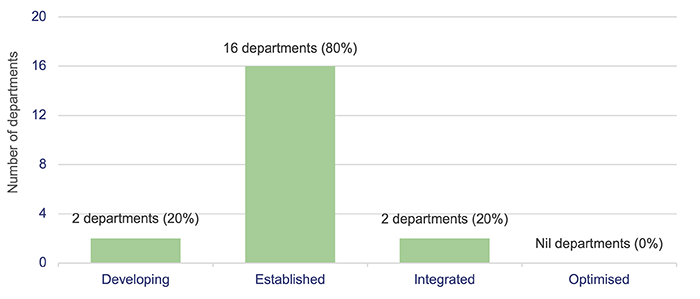Overview
Recent crisis management experiences such as COVID-19 and natural disasters have reinforced the need for Queensland's public sector to be flexible, and to work in a more unified way. While these conditions challenged business as usual, they also presented an opportunity for the sector to build a diverse and collaborative workforce, capable of agile, flexible, and innovative working practices.
Tabled 15 November 2022.

Report on a page
In this audit we examine the effectiveness of the Queensland public sector’s workforce planning to support an agile and flexible workforce that can meet changing needs and government priorities. Agile working is about getting work done with maximum flexibility and minimum constraints, so that the right people are in the right place at the right time.

Queensland Minimum Obligatory Human Resource Information (MOHRI) data at 30 June 2022.
Workforce planning and leadership
Greater direction and leadership are needed to develop an integrated approach to strategic workforce planning, and to shift from operational to transformational approaches. The current workforce planning framework is broad and visionary but has not translated to effective planning strategies. The pandemic showed that departments face and meet workforce challenges, but they do not have specific strategies to address all obstacles and support change. Workforce plans are more likely to include business-as-usual actions than specific initiatives or projects, with measures of success, to address challenges. There is an opportunity for more integrated and harmonised planning across the sector.
Workforce transformation
The adoption of new technology continues to gain pace, reshaping how we work and deliver services. Many job tasks will be automated, new tasks will emerge, and some job roles will evolve with new responsibilities.
The Queensland public sector’s current assessment of the impact of technology on the workforce is inadequate to provide insights into how the workforce could change and identify opportunities to improve service delivery. The sector does not fully know what new skills will be needed. More analysis is needed on how to improve workforce skills, tools, and abilities, to keep up with the constant changes. Workforce analysis mainly focuses on workforce profile and does not give a clear picture of existing workforce capability across the sector. This makes it difficult to assess what critical skills and capabilities are needed to transform the public sector and make it relevant for the changing environment.
Attracting and retaining talent
Barriers to attracting and retaining talent mean that many departments lack the right resources and skills to operate efficiently and effectively. In an increasingly competitive labour market, particularly for specialist skills and deep expertise, more modern and timely recruitment processes are needed. But the sector also needs to find more innovative ways to attract and retain the talent it needs.
To become a more dynamic and responsive organisation, the public sector needs flexible work practices that meet both organisational and employee needs, including ways of moving employees more easily across the sector.

1. Audit conclusions
Workforce planning in the Queensland public sector is not sophisticated enough to build and grow a workforce that can meet changing needs and priorities. The sector is being impacted by changing citizen demographics and expectations of government services, digital transformation, and increasing demand for skills and talent in a highly competitive labour market. Employee expectations are also changing, demanding different work and workforce models. The sector needs to implement better strategies to create a skilled workforce with the ability to respond and adapt quickly to these challenges. More needs to be done to assess and respond to the impact of emerging technology and opportunities presented through data and digital transformation.
This requires a move away from traditional ways of operating. The public sector is unwieldy due to long‑established hierarchical structures and processes, and a silo approach. There is an increasing need for whole-of-government solutions rather than a portfolio approach to service delivery. Leadership needs to be systemic: focused across the broader public sector, as well as within individual departments. A more coordinated approach to workforce planning would also allow common issues of concern – such as employee mobility and capability building – to be addressed from a whole of public sector perspective. Public sector human resources staff also need more support to develop skills for strategic workforce planning and to address challenges.
Talent shortages will continue to affect the public sector workforce, particularly for specialist skills and deep expertise. It needs effective attraction and retention strategies, including a strong employee value proposition, contemporary recruitment processes, and a flexible structure.
Flexibility empowers employees to find balance and wellbeing, and to be more productive. Using technology and finding new ways to work can reduce bureaucratic process and increase efficiency.
Recent crisis management experiences such as COVID-19 and natural disasters have reinforced the need for the public sector to be flexible, and to work as one. While the pandemic disrupted business as usual, it also presented opportunities for transformational change which the sector needs to build on.

2. Recommendations
We make the following recommendations in this report. Some recommendations are directed to the Public Service Commission as the entity responsible for supporting Queensland public sector agencies to effectively manage their workforce, and to prepare for and respond to strategic workforce challenges.
|
We recommend the Public Service Commission: |
|
|
We recommend all Queensland Government departments: |
|
Reference to comments
In accordance with s. 64 of the Auditor-General Act 2009, we provided a copy of this report to relevant entities. In reaching our conclusions, we considered their views and represented them to the extent we deemed relevant and warranted. Any formal responses from the entities are at Appendix A.

3. Workforce planning − leadership
This chapter is about how the Queensland public sector plans for and develops workforce capabilities needed for the future. We look at both the sector-wide workforce management frameworks and strategies, and how effective workforce planning is within departments.
The entities we audited include the Public Service Commission and the 20 government departments listed in Appendix C.
Overview of workforce planning framework
The Queensland public sector is large and diverse. It employs more than 240,000 people working across almost 4,000 different locations, delivering vital services to the community. Nine out of 10 public servants are either frontline workers, such as doctors, teachers, police officers and paramedics, or they support frontline workers.
Operating in an environment of rapid change and uncertainty increases pressure on organisations to have the talent needed to meet changing business priorities. Many complex problems faced by government span agency boundaries. This reinforces the need for an integrated approach to developing an effective public sector workforce.
Public Service Commission
The Public Service Commission (PSC) plays a critical role in leading the sector’s approach to strategic workforce planning. It developed an outlook and roadmap to show how the public sector workforce will change over a 10-year period and how to prepare for the changing and complex environment:
- 10-year Human Capital Outlook (2017) − outlines the aspirational goals for the Queensland public sector
- 3-year Human Capital Strategic Roadmap (revised 2022) – provides a pathway for continued workforce transformation across the sector.
PSC developed the outlook and roadmap in partnership with directors-general and chief human resource officers.
PSC provides strategic workforce advice and support to agencies, including a strategic workforce planning framework, and workforce data. It has developed information on strategic talent acquisition, modelling workforce supply and demand, and developing capability and skills. PSC also coordinates sector-wide initiatives on inclusion and diversity, employee health and wellbeing, flexible work, and mobility.
Government agencies
The Queensland Government Performance Management Framework Specific Purpose Planning Requirements state that all Queensland Government agencies (departments and statutory bodies) must have a strategic workforce plan, and update it annually as part of their strategic planning process.
Agencies’ strategic workforce plans should address current and future workforce matters to ensure they have the right structure and the right people to deliver their strategic objectives. This includes:
- reviewing their structures and systems to ensure they are responsive to changing needs
- considering future capability requirements for potential augmentation and automation impacts, reskilling, and upskilling opportunities.
Governance
An established governance structure guides strategic workforce planning across the sector. The PSC Chief Executive and the CEO Leadership Board hold overall responsibility and accountability. PSC collaborates with the sector through the Strategic Workforce Council.
- The CEO Leadership Board provides whole-of-sector oversight and stewardship.
- The Strategic Workforce Council is the peak consultative and advisory body for strategic workforce priorities in the Queensland Public Service (QPS). Membership includes PSC and the most senior human resources (HR) representative from the 20 core departments that make up the CEO Leadership Board.
Lack of traction in embedding the 10-year Human Capital Outlook into department strategies
Both the 10-year Human Capital Outlook and 3-year Human Capital Strategic Roadmap set out broad directions for the sector and are visionary in scope. But, 5 years in, it is difficult to see what they have achieved. There are no clear objectives or expected outcomes to measure progress. More practical and cohesive strategies are needed to transform the workforce, supported by measures of success.
Significant effort and work has been put in both centrally and by the 20 government departments, but it has not been brought together in a cohesive manner. Current workforce planning may be sufficient for business as usual, but not for transforming the workforce to deal with changing demands and emerging challenges.
There is opportunity for more to be driven centrally, to build on existing sector-wide approaches to mobility, flexible working, inclusion and diversity, and developing leadership competencies. Other strategies can be driven at the individual departmental level. A more integrated approach is needed with clarity on what needs to be done, and who is best placed to do it.
Greater leadership needed to drive transformational workforce planning
More leadership engagement is needed at both the system and departmental levels to shift workforce planning from business as usual, to more transformational.
The current 10-year Human Capital Outlook and 3-year Human Capital Strategic Roadmap are not providing the practical direction needed. While the CEO Leadership Board and Strategic Workforce Council partner with PSC on strategic workforce planning, most departments see that greater sector-wide direction and leadership would help develop a clear, unified approach to strategic workforce planning.
|
For 50% of the departments surveyed, HR professionals champion workforce planning with lesser involvement from executive teams. |
We found that leadership involvement in workforce planning in departments could be improved. Executive teams should lead strategic workforce planning, in collaboration with human resource professionals, and integrate it with organisational strategic planning.
Having centrally developed and driven strategies that have a more sector-wide applicability will allow more integrated and harmonised planning across the sector.
Most workforce plans are basic and compliance-driven
Figure 3A shows that only 10 of the 20 departments have developed and implemented a strategic workforce plan that meets the compliance requirements set out in the Performance Management Framework Specific Purpose Planning Requirements.
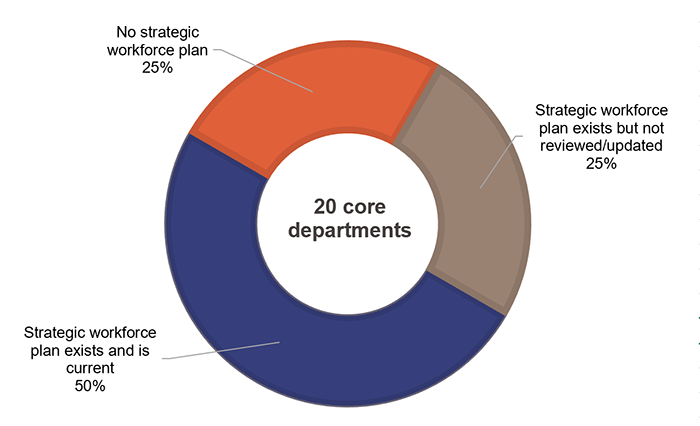
Compiled by Queensland Audit Office from survey responses and review of workforce plans.
Most plans include actions for success or goals but are more likely to be based on business as usual rather than specific initiatives or projects to address key challenges. Departments need clearer workforce strategies and projects for workforce transformation.
Strategic workforce planning across the departments is not yet mature enough to effectively meet changing demands. With few exceptions, strategic workforce planning is not integrated with business planning, reducing its value.
Figure 3B shows that in our survey, 80 per cent of departments self-assessed themselves as having an ‘established’ maturity level for workforce planning and management. We accepted the information provided by departments in the survey responses. We validated some but not all responses. Most departments have workforce planning processes and are doing the compliance and business-as-usual activities well. But they need to focus more strategically on addressing challenges impacting the workforce.
We use 4 levels of maturity, which are defined as:
- developing – an entity’s processes for workforce planning and management are operational, ad hoc, static or reactive
- established (standard) – an entity has structured processes for performing workforce planning and managing its workforce that is more proactive with executive involvement
- integrated (intermediate) – an entity’s processes for workforce planning and management are executive-led, managed, and focused
- optimised (complex) – the entity consistently demonstrates continuous improvement in workforce planning and management, and evaluates its performance regularly.
Barriers to developing transformational strategies include a lack of analysis skills and expertise to assess future needs. We found more work is needed in:
- identifying and diagnosing critical challenges
- developing an approach to deal with, or overcome, obstacles identified in the diagnosis
- taking coherent steps to accomplish outcomes set out in the approach.
Figure 3C is an example of where more work is needed in diagnosing the causes of critical challenges and developing initiatives and strategies to address them.
|
Addressing issues around workload and health |
|---|
|
The annual Working for Queensland survey measures Queensland public sector employees’ perceptions of their work, manager, team, and organisation. It is open to all employees of government departments and statutory bodies (excluding school-based employees). The survey results show that from 2016 to 2020, only 39 or 40 per cent of the workforce surveyed rated workload and health as positive. The drop in 2021 is likely related to the impact of COVID-19. Workload and health: 2016−2021 Source: Working for Queensland surveys. All 15 departments who had a strategic workforce plan included a commitment to the health, safety, and wellbeing of employees. However, the survey results indicate that the sector has not effectively addressed issues around workload and the health of its workforce. In addition to more work needed in diagnosing and taking coherent steps to overcome challenges, the lack of measurable indicators of success gives limited visibility of progress of any strategies and initiatives in place. |
Compiled by Queensland Audit Office from Working for Queensland and audit survey results.
Lack of capability for strategic workforce planning
Most departments report a lack of skills and capacity for contemporary strategic workforce planning. Human resources staff generally focus on transactional and operational functions such as payroll administration, recruitment processes, and performance management.
Workforce guidance provided by PSC aims to support agencies to adopt, adapt, and embed sector-wide workforce strategies into agency-level workforce strategies and plans. But departments reported that they found the information principle-based and needed more practical ‘how-to’ guidance. Some departments noted a more unified and centrally supported approach to developing and implementing workforce strategies across the sector would be beneficial.
Indicators of success needed to track achievements
Neither the 10-year Human Capital Outlook or 3-year Human Capital Strategic Roadmap include measurable indicators of success, which means there is limited visibility of how the sector is progressing. Most of the departments’ strategic workforce plans have no or limited performance indicators or criteria to measure and monitor success.
PSC refreshed the 3-year Human Capital Strategic Roadmap in 2022 and reviewed progress against the original roadmap. But, with no measurable indicators of success, progress was captured as actions taken, rather than outcomes achieved. For example, workplace improvements included increased access to flexible work and the launch of Flexible by Design, a framework to guide flexible work decision-making within the sector.
Monitoring, evaluating, and reporting on sector performance, as well as the performance of strategic workforce plans in many departments, needs development. There is a lack of systems and processes to determine whether the current plans to address workforce issues have been effective.
Workforce dashboard
The Queensland public sector no longer produces a state-of-the-sector report, or has a central view on how the sector’s workforce is performing overall. Developing a sector-wide workforce dashboard would allow senior executives and workforce analysts to view how their department or agency is performing against key workforce metrics, including agreed key performance indicators.
A centralised dashboard would give a coherent overview of the sector’s performance, providing easy access to information and improving visibility. Information could include:
- indicators – overview of how agencies are performing across a broader range of workforce measures over time
- benchmarking – shows how agencies compare against peers and sector average.
Figure 3D shows examples of measures used for monitoring employee engagement and wellbeing.
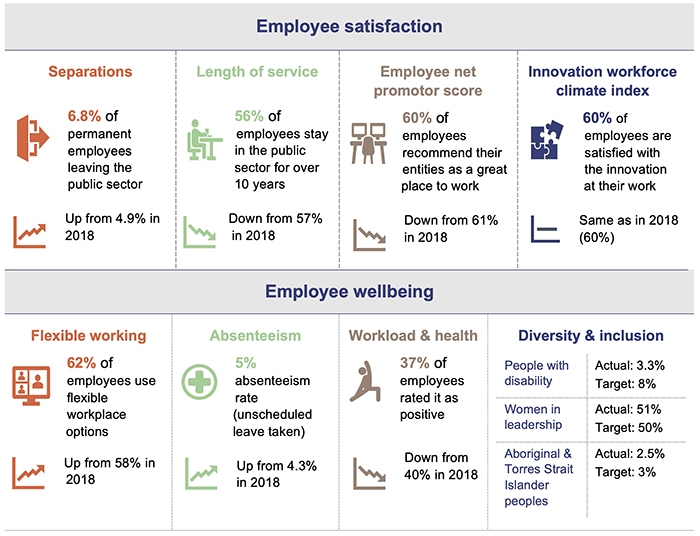
Note: Diversity and inclusion targets represent the proportion of people in the Queensland public sector workforce.
Compiled by Queensland Audit Office using MOHRI and Working for Queensland survey data.
|
Recommendation 1 We recommend that the Public Service Commission provides greater central leadership and an integrated approach to strategic workforce planning to address current and future challenges. This includes: a) providing practical guidance on specific initiatives to address key workforce challenges b) supporting agency human resources staff to develop skills needed for strategic workforce planning and to address challenges c) developing clear indicators of success to measure performance and progress across the sector. |
|
Recommendation 5 We recommend all Queensland Government departments ensure strategic workforce planning is driven by leaders and integrated with organisational planning. This includes considering their workforces as part of the broader sector workforce to support greater mobility. |

4. Workforce planning − transformation
This chapter looks at how the Queensland public sector assesses future workforce and capability needs and the impact of technology to develop flexible and responsive workforce models.
Workforce transformation overview
Workforce transformation is the method of improving workforce skills, tools, and abilities to keep up with the constant changes in an organisation's business strategy and external environment. To ensure it has the right skills to match its strategic needs, an organisation should assess existing skills, identify skills needed to meet future goals, and map out any skills gaps. Identified gaps are closed through targeted reskilling, upskilling, and hiring.
During the COVID-19 pandemic, technological and workplace cultural shifts expected to take place years into the future came rapidly in response to the new reality. Organisations have always needed to pivot to avoid falling behind. However, as the pace of technological change increases, these transformations are necessary more often, and need to be done on a shorter time scale. This means that organisations need effective workforce transformation programs to ensure they can align their skills base with future goals and needs.
More dynamic approach needed to meet future workforce needs
Preparing a workforce for the future demands a more dynamic approach. More diagnosis is needed on how to improve workforce skills, tools, and abilities, to keep up with constant change.
Workforce analysis done by many departments does not give a clear picture of their workforce capability, because it mainly focuses on workforce profile. This makes it difficult to assess what critical skills and capabilities are needed to transform the public sector and make it relevant for the changing external environment.
|
85% of departments say they need better strategies to address gaps between current and future workforce needs. |
The current assessment of how technology, increased use of data, and customer demands will impact the workforce, is insufficient to provide insights into how the workforce could change and identify opportunities to improve service delivery. This includes understanding what new skills are needed.
No clear picture of current public sector workforce characteristics and future needs
There is no real assessment and understanding of the public sector’s current workforce capability and skills, limiting the ability to understand future skill needs. This requires better use of existing technology or considering alternate platforms to capture all information on employee capability. To respond to change, more information and analysis is needed on what occupational groups and roles are likely to be impacted by digital developments and identifying underutilised skills and roles.
Published twice a year, the state government’s Queensland public sector workforce profile summarises the sector’s workforce. It provides data on the roles, earnings, location of its workforce and workforce diversity, at a point in time. But this information is based on the current payroll data, and does not show movement over time or projected future needs.
|
80% of the departments surveyed have only a limited understanding of what the future workforce looks like. |
Whole-of-government effort and support is needed for a robust assessment of future workforce characteristics to identify skills gaps.
Not sufficiently assessing existing skills, identifying skills needed to meet future goals, and mapping out any skills gaps, makes it difficult to design strategies to meet future workforce requirements.
Workforce analysis to help inform what is needed to achieve outcomes includes:
- identifying changing roles, capability, and skill needs
- understanding how the public sector needs to pivot to meet changing service delivery needs and impacts on its workforce
- considering broader workforce indicators such as population growth, separation rates, and demographics, to develop a sense of what may transpire.
Figure 4A provides examples of the type of analysis possible using currently available data.
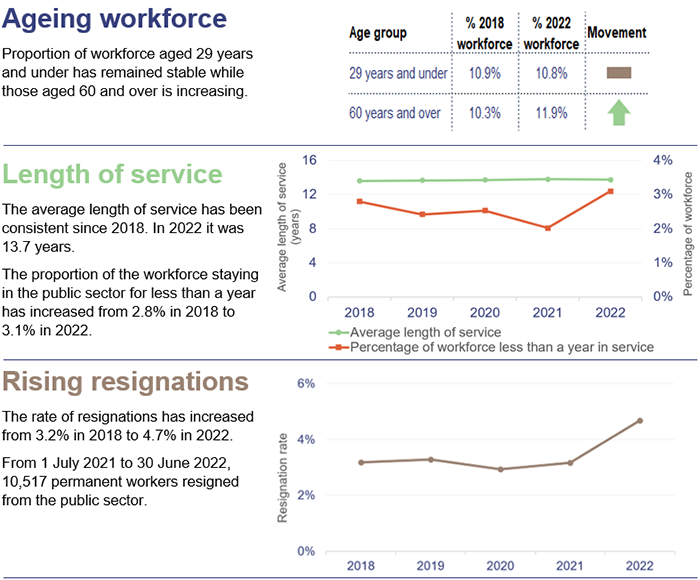
Compiled by Queensland Audit Office using MOHRI data.
Limited assessment of emerging technologies
More needs to be done to assess and respond to the impact of emerging technology, and the opportunities presented through data and digital transformation. Not keeping pace with technology changes means the sector risks being left behind. But transitioning adeptly brings opportunities in terms of better service delivery for the community and greater engagement by the public sector workforce. New technology can empower the workforce and is key to employee retention.
Technology functionality and adoption continues to grow exponentially, reshaping how we work and deliver services. Many job tasks will be automated, new tasks will emerge, and some job roles will transition with new responsibilities. The challenge is how to transition the public sector workforce to a new digitally enabled state economy.
In 2019, PSC commissioned work to explore future shifts in the Queensland public sector’s operating environment. The report reflected on major changes in how work is done, how the sector operates, and the types of services and skills in demand. It included future impacts of automation and new technology and identified areas where the sector could improve the delivery and efficiency of government services.
|
75% of the departments surveyed do no or limited assessment of the impacts and benefits of emerging technology. |
PSC shared the report with the CEO Leadership Board and Strategic Workforce Council and provided briefings to some agencies’ executive leaders. But the report was not broadly communicated or built into departmental strategies. This presents a lost opportunity to understand and drive opportunities for change.
Emerging technologies could lead to fewer people needed for the same level of output, or mean that workers in some jobs will need to acquire new skills and aptitudes. But automation and digitisation are also creating jobs, with increasing demand for professions such as data scientists, cyber security specialists, and many types of computer programmers.
|
Recommendation 6 We recommend all Queensland Government departments implement better strategies to address challenges and create a skilled workforce. This includes: a) undertaking a robust assessment of existing and future workforce skills needed to meet goals, and identifying any skills gaps b) assessing the impact of emerging technology and digital transformation on service delivery, workplace infrastructure, and workforce demand. |
Figure 4B shows how one department identified jobs impacted by automation, and how staff can be reskilled to address current and future skill gaps. The challenge is to apply this approach to the broader public sector.
|
Reskilling staff to meet workforce needs |
|---|
|
Purpose The Customer and Digital Strategy unit within the Department of Communities, Housing and Digital Economy is coordinating an information and communication technology (ICT) workforce working group, established to address cross-agency ICT challenges. The working group aims to build ICT capacity and capability across the sector and address the pain points of skill shortages and difficulties in attracting and retaining talent. Challenges A lack of available ICT resources is impacting service delivery and the current workforce wellbeing. The sector has typically relied on a mix of public servants, contractors, and external services to provide outcomes. But the high demand for contingent labour is making it both difficult to attract contractors to work in the public sector, and increasingly more expensive. The working group is reviewing how the mix can be adjusted to meet current and future demands. After commencing in March 2022, the working group is still developing the initiative and scope, but its first project is to develop technical skills in-house to address skill gaps, with an initial focus on business analysts. Business analyst career pathway The working group identified that there are roles within the sector that will be impacted by automation. Work is underway to identify potential staff to undertake business analysis training. These staff members will also receive coaching from experienced business analysts. By building specialist capability in-house and embedding that in the business, it aims to address current and future skill gaps. Reskilling staff also provides them with new career opportunities. |
Compiled by Queensland Audit Office from information provided by Department of Communities, Housing and Digital Economy.

5. Attracting and retaining talent
This chapter looks at what the Queensland public sector is doing to attract and retain the skills and expertise needed to develop an agile and responsive workforce to meet service delivery needs and government priorities.
Public sector recruitment
The Queensland public sector operates in an increasingly competitive labour market, particularly for specialist skills and deep expertise. It needs effective attraction and retention strategies, including a strong employee value proposition and contemporary recruitment processes.
Public sector recruitment processes are a barrier to attracting talent
The lack of contemporary recruitment methods makes it difficult to attract and recruit the best talent, limiting the ability to meet future workforce challenges.
Current recruitment and selection processes reflect the requirements prescribed in the Public Service Act 2008 and the directive Recruitment and selection (Directive 12/20). But processes are seen as slow, cumbersome, and overly complex. Lengthy position descriptions written in language understood by public servants are not necessarily easy to understand for external candidates. Analysis by PSC in 2022 identified unappealing advertising content led to missed candidate engagement and employment branding opportunities. Figure 5A provides a snapshot of issues experienced.
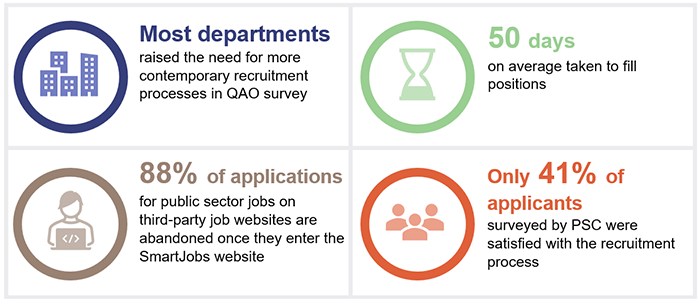
Compiled by Queensland Audit Office from survey responses and information provided by Public Service Commission.
Most departments noted challenges with current public sector recruitment processes. Many are looking at ways to move from traditional recruitment to contemporary talent acquisition methods. These include employer branding, partnering with higher education institutions, and targeted advertising campaigns including using social media.
Selling a strong value proposition can attract talent from outside the public sector. This includes showing how working in the public sector can positively impact people’s lives and advertising the role to attract people due to the unique function and nature of the work.
PSC recently commenced a review of the Queensland public sector recruitment and selection practices. It will cover developing contemporary recruitment practices that support the recruitment of a diverse workforce, while ensuring process integrity. Currently in the scoping phase, PSC expects to finalise the review in early 2023.
|
Recommendation 2 We recommended the Public Service Commission develops contemporary recruitment and selection practices that support the timely recruitment of a diverse workforce. This includes revisiting the sector's employment value proposition. |
Retaining talent in the public sector
Both potential and current employees are looking for competitive compensation, more flexibility, and an inclusive and healthy culture. Disruption to operating models experienced during COVID-19 reinforced the need for the public sector to employ new ways of working and streamline processes to best support the community, while safeguarding its workforce. This includes looking at ways to transfer capability across the sector and within departments.
The challenge now is to build on this experience to develop workforce models that continue to share and deploy resources where most needed, reduce duplication, and deliver effectively against government priorities.
Public sector remuneration is a barrier to attracting and retaining talent
Most departments strongly believe that the Queensland public sector employment arrangements, such as industrial awards, pay points, and bandings, are barriers to attracting and retaining talent.
The Queensland public sector average earnings are more than the national average and caught up with the Australian public sector average in 2022. However, uncompetitive salaries in some roles are making it difficult to attract and retain staff. For example:
- Specialists and technical experts are paid on the same bandings as non-technical roles. This makes it difficult to compete with the private sector, which offers higher salaries and benefits.
- There are limited career pathways for technical experts reaching manager-level positions. Employees with specialist skills may not want to move into managerial roles to be promoted.
These limitations are likely to worsen in the current labour market, and should therefore be reviewed and a way forward developed.
There are some options available to agencies to support the attraction and retention of employees. In special circumstances, agencies can pay employees higher remuneration by using fixed-term contracts or providing incentives. However, they can only be offered on a temporary basis, for a predetermined period.
Moving from flexible work practices to workplace flexibility
The use of flexible work options in the Queensland public sector has increased from 44 per cent to 62 per cent over the last 5 years. This increase is significant given that 9 in 10 roles in the Queensland public sector are frontline or frontline support roles, where the full range of flexible work options may not be operationally practical.
Figure 5B on results from the Working for Queensland survey shows the increased percentage of employees using flexible workplace options since 2016.
In 2021, the main flexible work options used by staff included:
- flexitime or accumulated hours − 47 per cent of staff
- telecommuting or remote working – 39 per cent of staff
- flexible work hours to meet external/family commitments – 24 per cent
- part-time work – 27 per cent of staff.
Flexibility in the workplace allows employers and employees to decide on working conditions that suit them. This helps employees maintain a work/life balance and can help employers improve the productivity and efficiency of their business.
Flexible working practices became critical for all levels of staff during COVID-19 and there is now a clear expectation among employees they will continue. Universally, demand for ongoing flexible work practices is increasing and is often important to staff feeling valued. Workplace flexibility can be used as a tool for engaging and retaining employees.
Employees are now looking for greater workplace flexibility through hybrid work models, offering employees the autonomy to choose where, how, and when to work productively. For consistency, the sector needs whole-of-government guidance on practical and sustainable hybrid workforce models that embed flexible ways of working in the sector, and which balance the needs of employees, teams, and organisations.
|
Recommendation 3 We recommend the Public Service Commission develops whole-of-government guidance on practical and sustainable hybrid workforce models. |
Silo approach limiting workforce mobility
There is an increasing need for whole-of-government solutions rather than a portfolio approach to service delivery. But the traditional portfolio approach to government and lack of common job roles makes this challenging. Greater workforce mobility across a more open and integrated public sector provides a sensible way to address the challenges of scaling up or down, and managing workload peaks and troughs. It develops government-wide perspectives and capability, aids professional development, and helps retain staff.
In practice, encouraging mobility can be difficult – managers may be reluctant to release high-performing people, and it is often seen as a one-way street. There is a risk of mobility programs being a mechanism for ‘parking’ non-performers.
But there is a strong case for mobility programs to build and nurture a capable and adaptable workforce that can be mobilised where and when needed. Allowing the workforce to be more mobile provides opportunities for employees to:
- gain practical experience and exposure to work across the sector
- improve skills
- foster more diverse thinking.
Common job roles for key occupations would ease mobility across the sector, including smoothing machinery of government changes. Currently there are no standard role descriptions for common jobs across the sector. For example, a customer service role in one department may have a different role description to one in another department at the same classification level requiring similar skills and capability.
Common sector role descriptions would provide consistency, support employee mobility, and create clarity around work expectations. They would also be a practical and efficient resource that could save work and money in developing duplicate role descriptions. Using simpler language and avoiding jargon in job descriptions could also help attract people from outside the public sector.
|
Recommendation 4 We recommend the Public Service Commission champions cross-sector workforce mobility programs and common job descriptions to build and nurture a capable and adaptable workforce. |
Employee mobility tools
The 10-year Human Capital Outlook and the 3-year Human Capital Strategic Roadmap emphasise the importance of employee mobility. PSC developed the following tools to assist mobility across the sector:
- Talent Now – operates as an online marketplace for short-term opportunities in the Queensland public sector. The platform allows interested employees to upload their resume, and for hiring managers to search the platform for appropriately skilled candidates.
- Employee Mobilisation Service – implemented in response to COVID-19 to move critical public sector resources to priority work during the pandemic.
While Talent Now is still available, it is not widely used. Of the 16 departments who responded to our question, 12 do not use the platform or only use it in a limited way. This is mainly due to lack of awareness on how to use the tool, and the tool not being user-friendly.
PSC reported that 783 employees were mobilised as part of the Employee Mobilisation Service. Of the 1,436 mobilisations that occurred (some employees were mobilised more than once), about half of the mobilisations were in Queensland Health, and around 15 per cent in the Queensland Police Service. The Employee Mobilisation Service demonstrates how workforce mobility can be effective. No longer in use, it has not resulted in greater use of, or new models of, mobility.
Figure 5C shows how one department has implemented initiatives to mobilise its existing workforce and attract new talent.
|
Attracting new talent and mobilising existing workforce |
|---|
|
The Department of Transport and Main Roads established several priority projects to develop its employees and future workforce. One example is a talent mobility project − delivering initiatives to mobilise the department’s existing workforce and attract talent to meet future skill needs. Key deliverables
Project status and impact – employee value proposition and employer brand refresh In November 2021, the department released the ‘TMR: An experience like no other’ brand for retention and recruitment that included: The refresh of the employee value proposition and employer brand has achieved the following outputs:
In addition, the department’s recent survey of its new starters identified positive impacts of the employer brand. For example, 86 per cent of the new starters surveyed mentioned that their expectations of working for the department have been met. The department is now using the insights from the survey to inform targeted initiatives to roll out phase 2 of the employer brand project. |
Note: TMR – Transport and Main Roads.
Compiled by Queensland Audit Office from information provided by the Department of Transport and Main Roads.
|
Recommendation 7 We recommend all Queensland Government departments move from traditional recruitment practices to contemporary talent acquisition approaches. This includes: a) modernising and simplifying job roles that focus on skill needs, facilitate mobility across the sector, and better align with comparable private sector roles b) finding more innovative ways to attract and retain talent. |


